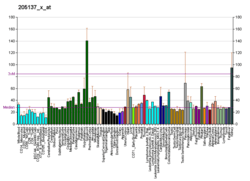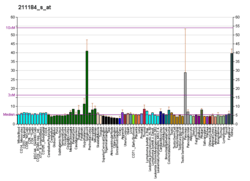USH1C
Harmonin is a protein that in humans is encoded by the USH1C gene.[5][6][7] Required for development and maintenance of cochlear hair cells.[5]
Interactions
USH1C has been shown to interact with CDH23.[8][9]
gollark: What do you mean a "bee"? Some sort of bee silkscreen art?
gollark: I don't really do hardware.
gollark: Fun fact of the day: `...` is a valid Python expression.
gollark: I'm sure you'd like us to think so.
gollark: This was confirmed using data and algorithms.
References
- GRCh38: Ensembl release 89: ENSG00000006611 - Ensembl, May 2017
- GRCm38: Ensembl release 89: ENSMUSG00000030838 - Ensembl, May 2017
- "Human PubMed Reference:". National Center for Biotechnology Information, U.S. National Library of Medicine.
- "Mouse PubMed Reference:". National Center for Biotechnology Information, U.S. National Library of Medicine.
- Verpy E, Leibovici M, Zwaenepoel I, Liu XZ, Gal A, Salem N, Mansour A, Blanchard S, Kobayashi I, Keats BJ, Slim R, Petit C (Sep 2000). "A defect in harmonin, a PDZ domain-containing protein expressed in the inner ear sensory hair cells, underlies Usher syndrome type 1C". Nature Genetics. 26 (1): 51–5. doi:10.1038/79171. PMID 10973247.
- Ahmed ZM, Smith TN, Riazuddin S, Makishima T, Ghosh M, Bokhari S, Menon PS, Deshmukh D, Griffith AJ, Riazuddin S, Friedman TB, Wilcox ER (Jun 2002). "Nonsyndromic recessive deafness DFNB18 and Usher syndrome type IC are allelic mutations of USHIC". Human Genetics. 110 (6): 527–31. doi:10.1007/s00439-002-0732-4. PMID 12107438.
- "Entrez Gene: USH1C Usher syndrome 1C (autosomal recessive, severe)".
- Boëda B, El-Amraoui A, Bahloul A, Goodyear R, Daviet L, Blanchard S, Perfettini I, Fath KR, Shorte S, Reiners J, Houdusse A, Legrain P, Wolfrum U, Richardson G, Petit C (Dec 2002). "Myosin VIIa, harmonin and cadherin 23, three Usher I gene products that cooperate to shape the sensory hair cell bundle". The EMBO Journal. 21 (24): 6689–99. doi:10.1093/emboj/cdf689. PMC 139109. PMID 12485990.
- Siemens J, Kazmierczak P, Reynolds A, Sticker M, Littlewood-Evans A, Müller U (Nov 2002). "The Usher syndrome proteins cadherin 23 and harmonin form a complex by means of PDZ-domain interactions". Proceedings of the National Academy of Sciences of the United States of America. 99 (23): 14946–51. doi:10.1073/pnas.232579599. PMC 137525. PMID 12407180.
Further reading
- Maruyama K, Sugano S (Jan 1994). "Oligo-capping: a simple method to replace the cap structure of eukaryotic mRNAs with oligoribonucleotides". Gene. 138 (1–2): 171–4. doi:10.1016/0378-1119(94)90802-8. PMID 8125298.
- Suzuki Y, Yoshitomo-Nakagawa K, Maruyama K, Suyama A, Sugano S (Oct 1997). "Construction and characterization of a full length-enriched and a 5'-end-enriched cDNA library". Gene. 200 (1–2): 149–56. doi:10.1016/S0378-1119(97)00411-3. PMID 9373149.
- Scanlan MJ, Chen YT, Williamson B, Gure AO, Stockert E, Gordan JD, Türeci O, Sahin U, Pfreundschuh M, Old LJ (May 1998). "Characterization of human colon cancer antigens recognized by autologous antibodies". International Journal of Cancer. 76 (5): 652–8. doi:10.1002/(SICI)1097-0215(19980529)76:5<652::AID-IJC7>3.0.CO;2-P. PMID 9610721.
- Jain PK, Lalwani AK, Li XC, Singleton TL, Smith TN, Chen A, Deshmukh D, Verma IC, Smith RJ, Wilcox ER (Jun 1998). "A gene for recessive nonsyndromic sensorineural deafness (DFNB18) maps to the chromosomal region 11p14-p15.1 containing the Usher syndrome type 1C gene". Genomics. 50 (2): 290–2. doi:10.1006/geno.1998.5320. PMID 9653658.
- Saouda M, Mansour A, Bou Moglabey Y, El Zir E, Mustapha M, Chaib H, Nehmé A, Mégarbané A, Loiselet J, Petit C, Slim R (Aug 1998). "The Usher syndrome in the Lebanese population and further refinement of the USH2A candidate region". Human Genetics. 103 (2): 193–8. doi:10.1007/s004390050806. PMID 9760205.
- Scanlan MJ, Williamson B, Jungbluth A, Stockert E, Arden KC, Viars CS, Gure AO, Gordan JD, Chen YT, Old LJ (Apr 1999). "Isoforms of the human PDZ-73 protein exhibit differential tissue expression". Biochimica et Biophysica Acta (BBA) - Gene Structure and Expression. 1445 (1): 39–52. doi:10.1016/s0167-4781(99)00033-0. PMID 10209257.
- Kobayashi I, Imamura K, Kubota M, Ishikawa S, Yamada M, Tonoki H, Okano M, Storch WB, Moriuchi T, Sakiyama Y, Kobayashi K (Oct 1999). "Identification of an autoimmune enteropathy-related 75-kilodalton antigen". Gastroenterology. 117 (4): 823–30. doi:10.1016/S0016-5085(99)70340-9. PMID 10500064.
- Scanlan MJ, Gordan JD, Williamson B, Stockert E, Bander NH, Jongeneel V, Gure AO, Jäger D, Jäger E, Knuth A, Chen YT, Old LJ (Nov 1999). "Antigens recognized by autologous antibody in patients with renal-cell carcinoma". International Journal of Cancer. 83 (4): 456–64. doi:10.1002/(SICI)1097-0215(19991112)83:4<456::AID-IJC4>3.0.CO;2-5. PMID 10508479.
- Bitner-Glindzicz M, Lindley KJ, Rutland P, Blaydon D, Smith VV, Milla PJ, Hussain K, Furth-Lavi J, Cosgrove KE, Shepherd RM, Barnes PD, O'Brien RE, Farndon PA, Sowden J, Liu XZ, Scanlan MJ, Malcolm S, Dunne MJ, Aynsley-Green A, Glaser B (Sep 2000). "A recessive contiguous gene deletion causing infantile hyperinsulinism, enteropathy and deafness identifies the Usher type 1C gene". Nature Genetics. 26 (1): 56–60. doi:10.1038/79178. PMID 10973248.
- Zwaenepoel I, Verpy E, Blanchard S, Meins M, Apfelstedt-Sylla E, Gal A, Petit C (2001). "Identification of three novel mutations in the USH1C gene and detection of thirty-one polymorphisms used for haplotype analysis". Human Mutation. 17 (1): 34–41. doi:10.1002/1098-1004(2001)17:1<34::AID-HUMU4>3.0.CO;2-O. PMID 11139240.
- Ishikawa S, Kobayashi I, Hamada J, Tada M, Hirai A, Furuuchi K, Takahashi Y, Ba Y, Moriuchi T (Apr 2001). "Interaction of MCC2, a novel homologue of MCC tumor suppressor, with PDZ-domain Protein AIE-75". Gene. 267 (1): 101–10. doi:10.1016/S0378-1119(01)00378-X. PMID 11311560.
- Ahmed ZM, Riazuddin S, Bernstein SL, Ahmed Z, Khan S, Griffith AJ, Morell RJ, Friedman TB, Riazuddin S, Wilcox ER (Jul 2001). "Mutations of the protocadherin gene PCDH15 cause Usher syndrome type 1F". American Journal of Human Genetics. 69 (1): 25–34. doi:10.1086/321277. PMC 1226045. PMID 11398101.
- Savas S, Frischhertz B, Pelias MZ, Batzer MA, Deininger PL, Keats BB (Jan 2002). "The USH1C 216G-->A mutation and the 9-repeat VNTR(t,t) allele are in complete linkage disequilibrium in the Acadian population". Human Genetics. 110 (1): 95–7. doi:10.1007/s00439-001-0653-7. PMID 11810303.
- Ouyang XM, Xia XJ, Verpy E, Du LL, Pandya A, Petit C, Balkany T, Nance WE, Liu XZ (Jul 2002). "Mutations in the alternatively spliced exons of USH1C cause non-syndromic recessive deafness". Human Genetics. 111 (1): 26–30. doi:10.1007/s00439-002-0736-0. PMID 12136232.
- Siemens J, Kazmierczak P, Reynolds A, Sticker M, Littlewood-Evans A, Müller U (Nov 2002). "The Usher syndrome proteins cadherin 23 and harmonin form a complex by means of PDZ-domain interactions". Proceedings of the National Academy of Sciences of the United States of America. 99 (23): 14946–51. doi:10.1073/pnas.232579599. PMC 137525. PMID 12407180.
- Boëda B, El-Amraoui A, Bahloul A, Goodyear R, Daviet L, Blanchard S, Perfettini I, Fath KR, Shorte S, Reiners J, Houdusse A, Legrain P, Wolfrum U, Richardson G, Petit C (Dec 2002). "Myosin VIIa, harmonin and cadherin 23, three Usher I gene products that cooperate to shape the sensory hair cell bundle". The EMBO Journal. 21 (24): 6689–99. doi:10.1093/emboj/cdf689. PMC 139109. PMID 12485990.
- Weil D, El-Amraoui A, Masmoudi S, Mustapha M, Kikkawa Y, Lainé S, Delmaghani S, Adato A, Nadifi S, Zina ZB, Hamel C, Gal A, Ayadi H, Yonekawa H, Petit C (Mar 2003). "Usher syndrome type I G (USH1G) is caused by mutations in the gene encoding SANS, a protein that associates with the USH1C protein, harmonin". Human Molecular Genetics. 12 (5): 463–71. doi:10.1093/hmg/ddg051. PMID 12588794.
External links
- GeneReviews/NCBI/NIH/UW entry on Usher Syndrome Type I
- USH1C human gene location in the UCSC Genome Browser.
- USH1C human gene details in the UCSC Genome Browser.
- Overview of all the structural information available in the PDB for UniProt: Q9Y6N9 (Human Harmonin) at the PDBe-KB.
- Overview of all the structural information available in the PDB for UniProt: Q9ES64 (Mouse Harmonin) at the PDBe-KB.
This article is issued from Wikipedia. The text is licensed under Creative Commons - Attribution - Sharealike. Additional terms may apply for the media files.







